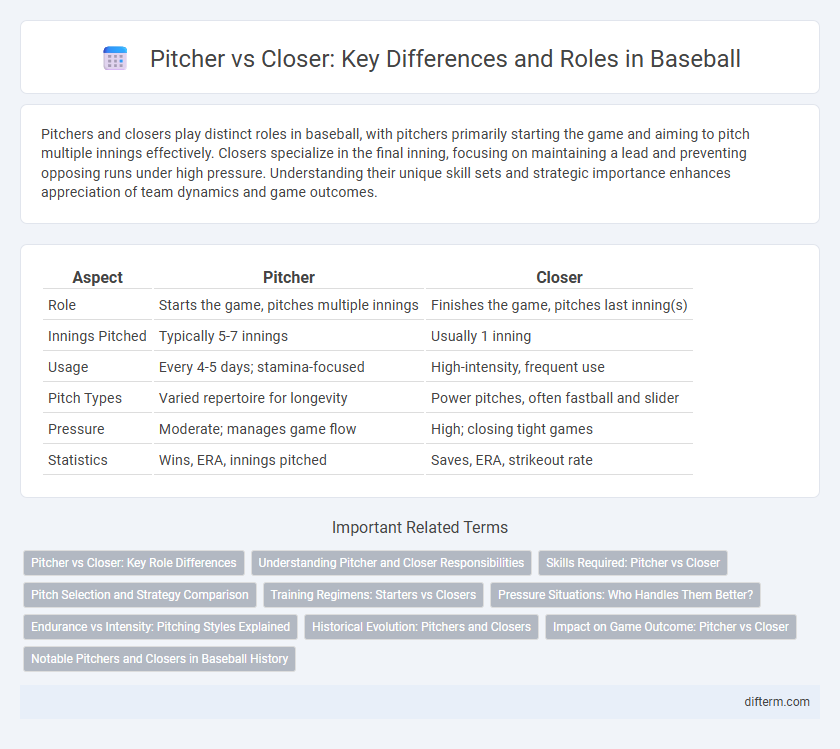Pitchers and closers play distinct roles in baseball, with pitchers primarily starting the game and aiming to pitch multiple innings effectively. Closers specialize in the final inning, focusing on maintaining a lead and preventing opposing runs under high pressure. Understanding their unique skill sets and strategic importance enhances appreciation of team dynamics and game outcomes.
Table of Comparison
| Aspect | Pitcher | Closer |
|---|---|---|
| Role | Starts the game, pitches multiple innings | Finishes the game, pitches last inning(s) |
| Innings Pitched | Typically 5-7 innings | Usually 1 inning |
| Usage | Every 4-5 days; stamina-focused | High-intensity, frequent use |
| Pitch Types | Varied repertoire for longevity | Power pitches, often fastball and slider |
| Pressure | Moderate; manages game flow | High; closing tight games |
| Statistics | Wins, ERA, innings pitched | Saves, ERA, strikeout rate |
Pitcher vs Closer: Key Role Differences
A pitcher typically starts the game and aims to face multiple batters over several innings, focusing on stamina and a diverse pitch arsenal, while a closer specializes in high-pressure situations, often pitching the final inning to secure a win. Closers rely heavily on velocity and strikeout ability to shut down opponents quickly, contrasting with starters who pace themselves for longevity. The strategic deployment of pitchers versus closers shapes game dynamics and impacts team success in critical moments.
Understanding Pitcher and Closer Responsibilities
Pitchers are primarily responsible for starting the game and pitching multiple innings to set the team's defensive tone, while closers specialize in pitching the final innings to secure a victory under high-pressure situations. Understanding the distinct roles involves recognizing that starters require stamina and control to face batters multiple times, whereas closers rely on velocity and mental toughness to shut down the opposition in crucial moments. Effective team strategy hinges on deploying pitchers who can efficiently manage innings, and closers who excel at maintaining leads in late-game scenarios.
Skills Required: Pitcher vs Closer
Pitchers require endurance, command of multiple pitch types, and strategic game management to navigate through opposing lineups over several innings. Closers demand exceptional mental toughness, velocity, and precision to dominate high-pressure situations often in the final inning. Both roles necessitate refined pitch control and the ability to adapt pitches based on batter tendencies and game context.
Pitch Selection and Strategy Comparison
Pitchers typically rely on a diverse pitch selection, including fastballs, curveballs, sliders, and changeups to navigate multiple innings and exploit hitters' weaknesses. Closers focus on high-intensity pitches, often emphasizing fastballs and sharp breaking balls to maximize strikeouts in high-leverage situations. Strategic differences include pitchers managing batter familiarity and stamina, while closers prioritize aggressive pitch placement and mental toughness to secure the final outs.
Training Regimens: Starters vs Closers
Pitchers and closers follow distinct training regimens tailored to their roles, with starters emphasizing endurance and stamina through extended bullpen sessions and long-toss routines. Closers concentrate on explosive power and recovery, incorporating shorter, high-intensity bullpen work and specialized conditioning for quick arm regeneration. These focused training strategies optimize performance by aligning physical preparation with the unique demands of starting and closing roles in baseball.
Pressure Situations: Who Handles Them Better?
Closers excel in high-pressure situations by entering games during critical final innings, often with runners on base and the outcome hanging in the balance, making their ability to manage stress and execute pitches under intense scrutiny paramount. Starting pitchers face pressure over multiple innings, but closers are specifically trained to thrive in do-or-die moments, showcasing mental toughness and pinpoint control. Statistical analysis reveals closers maintain lower ERA and WHIP in save opportunities, reflecting superior performance when the stakes are highest.
Endurance vs Intensity: Pitching Styles Explained
Pitchers rely on endurance to maintain consistent performance over multiple innings, showcasing stamina and control in every pitch. Closers prioritize intensity, delivering high-velocity throws with maximum effort during critical final moments to secure wins. This distinct contrast in pitching styles highlights the strategic balance between sustained stamina and explosive power in baseball.
Historical Evolution: Pitchers and Closers
Pitchers have traditionally served as the backbone of a baseball team's defense, evolving from complete-game starters to specialized roles including middle relievers and setup men. Closers emerged prominently in the 1970s, revolutionizing late-inning strategies by specializing in securing wins during the final inning. This historical shift reflects the increasing emphasis on bullpen management and situational pitching in modern baseball.
Impact on Game Outcome: Pitcher vs Closer
Starting pitchers influence game outcomes by setting the tone through multiple innings, controlling the opposing team's offense early and maintaining momentum. Closers impact results in high-leverage situations, often facing the final batters to secure narrow leads and finalize victories. Effective deployment of both roles maximizes a team's chances by combining endurance with situational dominance.
Notable Pitchers and Closers in Baseball History
Notable pitchers like Sandy Koufax and Nolan Ryan revolutionized baseball with their endurance and dominant fastballs, securing legendary careers with numerous strikeouts and Cy Young Awards. Closers such as Mariano Rivera and Trevor Hoffman redefined late-inning pitching by mastering the art of saves with precision and composure, holding records for most saves in MLB history. The strategic roles of starting pitchers and closers continue to shape game outcomes, emphasizing the importance of stamina versus specialized high-pressure performance.
pitcher vs closer Infographic

 difterm.com
difterm.com